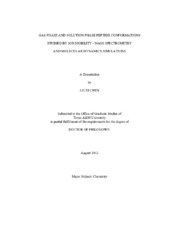| dc.description.abstract | Ion mobility spectrometry (IMS) separates ions on the basis of ion-neutral collision cross-sections (CCS, [omega]), which are determined by the geometry or conformation of the ions. The size-based IM separation can be extended to distinguish conformers that have different shapes in cases where shape differences influence the accessible surface area of the molecule. In recent years, IM has rapidly evolved as a structural characterization technique, which has applied on various structural biology problems. In this work, IMS is combined with molecular dynamics simulation (MDS), specially the integrated tempering sampling molecular dynamics simulation (ITS-MDS) to explore the gas-phase conformation space of two molecular systems (i) protonated tryptophan zipper 1 (trpzip1) ions and its six derivatives (ii) alkali metal ion (Na, K and Cs) adducts of gramicidin A (GA). The structural distributions obtained from ITS-MDS are compared well with results obtained from matrix-assisted laser desorption ionization-ion mobility-mass spectrometry (MALDI-IM-MS) for trpzip 1 series and electrospray ionization-ion mobility-mass spectrometry (ESI-IM-MS) for alkali metal ion adducts of GA. Furthermore, the solvent dependence on conformational preferences of the GA dimer is investigated using a combination of mass spectrometry techniques, viz. ESI-IM-MS and hydrogen/deuterium exchange (HDX)-MS, and MDS. The IM experiments reveal three distinct gramicidin A species, detected as the sodium ion adduct ions, [2GA + 2Na]²⁺, and the equilibrium abundances of the dimer ions varies with solvent polarity. The solution phase conformations are assigned as the parallel and anti-parallel [beta]-helix dimer, and the anti-parallel dimer is the preferred conformation in non-polar organic solvent. The calculated CCS profiles by ITS-MDS agree very well with the experimentally measured CCS profiles, which underscore the utility of the method for determining candidate structures as well as the relative abundances of the candidate structures. The benefit of combining ion mobility measurements with solution-phase H/D exchange is allowing identifications and detail analysis of the solution-phase subgroup conformations, which cannot be uncovered by one method alone. | en |


